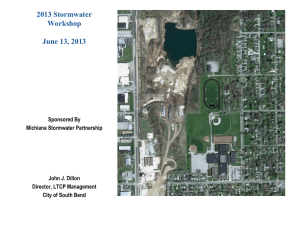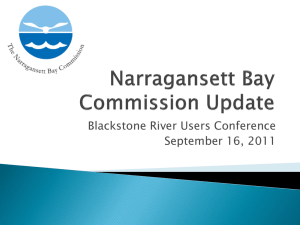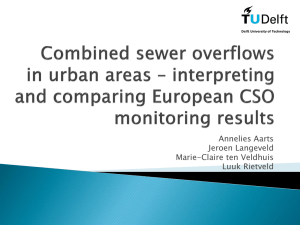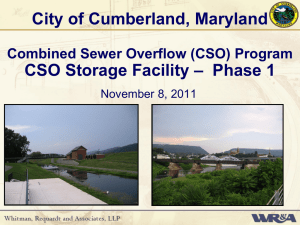CSO Reduction Program
advertisement
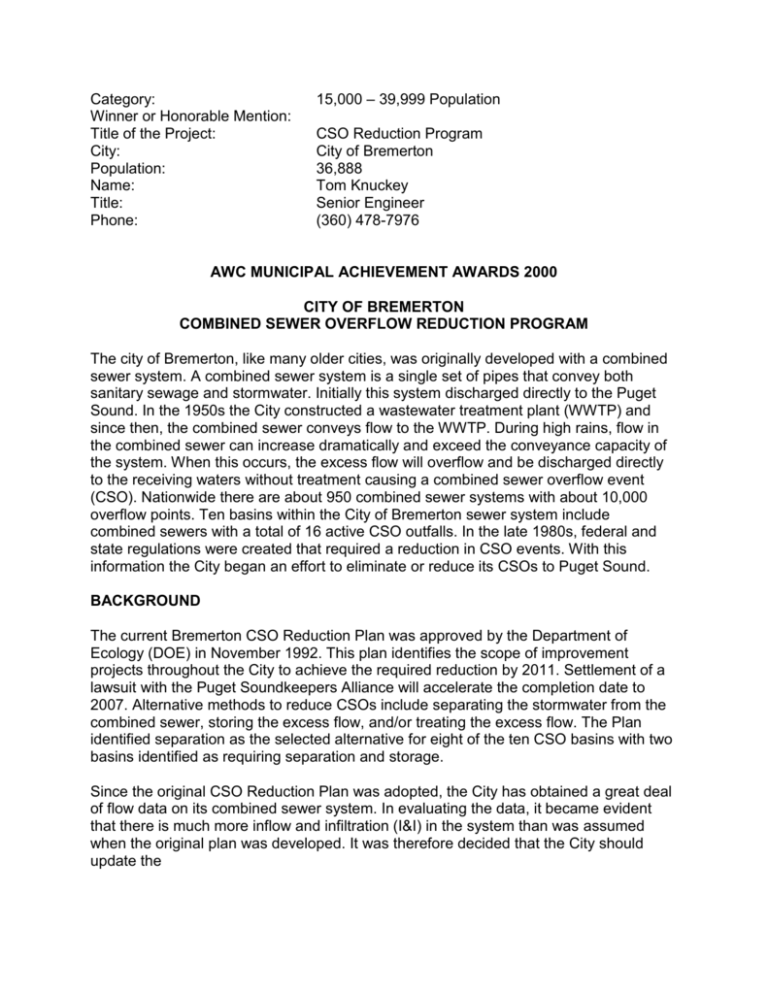
Category: Winner or Honorable Mention: Title of the Project: City: Population: Name: Title: Phone: 15,000 – 39,999 Population CSO Reduction Program City of Bremerton 36,888 Tom Knuckey Senior Engineer (360) 478-7976 AWC MUNICIPAL ACHIEVEMENT AWARDS 2000 CITY OF BREMERTON COMBINED SEWER OVERFLOW REDUCTION PROGRAM The city of Bremerton, like many older cities, was originally developed with a combined sewer system. A combined sewer system is a single set of pipes that convey both sanitary sewage and stormwater. Initially this system discharged directly to the Puget Sound. In the 1950s the City constructed a wastewater treatment plant (WWTP) and since then, the combined sewer conveys flow to the WWTP. During high rains, flow in the combined sewer can increase dramatically and exceed the conveyance capacity of the system. When this occurs, the excess flow will overflow and be discharged directly to the receiving waters without treatment causing a combined sewer overflow event (CSO). Nationwide there are about 950 combined sewer systems with about 10,000 overflow points. Ten basins within the City of Bremerton sewer system include combined sewers with a total of 16 active CSO outfalls. In the late 1980s, federal and state regulations were created that required a reduction in CSO events. With this information the City began an effort to eliminate or reduce its CSOs to Puget Sound. BACKGROUND The current Bremerton CSO Reduction Plan was approved by the Department of Ecology (DOE) in November 1992. This plan identifies the scope of improvement projects throughout the City to achieve the required reduction by 2011. Settlement of a lawsuit with the Puget Soundkeepers Alliance will accelerate the completion date to 2007. Alternative methods to reduce CSOs include separating the stormwater from the combined sewer, storing the excess flow, and/or treating the excess flow. The Plan identified separation as the selected alternative for eight of the ten CSO basins with two basins identified as requiring separation and storage. Since the original CSO Reduction Plan was adopted, the City has obtained a great deal of flow data on its combined sewer system. In evaluating the data, it became evident that there is much more inflow and infiltration (I&I) in the system than was assumed when the original plan was developed. It was therefore decided that the City should update the CSO Reduction Plan, and re-evaluate all of the CSO basins to confirm that the identified reduction strategy is correct. We have found that separation alone will not solve the overflow problem, and that in addition to some separation and storage, expansion of the existing WWTP for wet weather flows and construction of a second CSO Treatment Plant is required. The city is aggressively pursuing operations modifications, system modifications and capital construction to meet the 2007 CSO reduction deadline. The city has been extremely successful in meeting these goals using a mixture of staff, consultants and contractors. CSO REDUCTION PROGRAM Flow Monitoring. One of the first program accomplishments was installation of flow monitoring equipment at each of the CSO structures within the City. The equipment was installed using City staff in 1994 and 1995, and has been operating continuously ever since. The information obtained from this equipment has proven invaluable in helping City staff understand the frequency and quantity of overflows. In addition to allowing accurate reporting of events, the data has allowed the City to accurately calibrate its hydraulic model of the combined system. This hydraulic model is used as a tool to determine the baseline flows and for designing system improvements. Overflow Structure Improvements. The City has aggressively pursued CSO reduction and has made every effort to maximize and optimize the existing combined system wherever possible. Nearly all of the overflow structures have been modified since 1994. The modifications were typically made to increase the accuracy of the flow monitors, and to surcharge the pipes conveying the flows so that the pipe volume could be used for storage. Surcharging the system for storage in this manner requires a rather painstaking investigation and survey in most cases to ensure that the adjacent residents and businesses will not be adversely affected by the work. Storing flow in the existing system in this manner has eliminated many overflows that would have occurred from smaller storms. Further, since construction of storage will cost the City in excess of $2.50 per gallon, surcharging the existing system is a very cost- effective way of providing the needed storage while helping to minimize future capital expenditures. Flow Slipping. The City has also made a concerted effort to identify all catch basins that can be plugged to convey water that would otherwise enter the combined system along the streets into a separated catch basin, or other stormwater conveyance. Again, this is a very cost-effective way for the City to immediately make a considerable reduction in CSOs. To date, approximately 150,000 square feet of city streets have been eliminated which has resulted in literally hundreds of thousands of gallons of overflow reduction. Smoke and Dye Testing. Most of the combined sewers within the City were constructed before 1940. In many cases no construction drawings of the sewers currently exist, and when they do, adequate detail isn't included to identify all of the connections to the sewer. To help understand our system, and to help identify sources of inflow, City sewer crews have spent months performing smoke and dye tests on the existing system. Smoke testing consists of opening a manhole and forcing non-toxic smoke into the combined system. The smoke will engulf the sewer and exit through catch basins, driveway drains, roof gutters, and devices that are connected to the sewer. This is a very quick and accurate method of confirming inflow sources. However in some cases, lines connected to the sewer have a low spot that acts as a p-trap and the smoke will not blow through. If this condition is suspected, crews inject dye and flow water into the suspect device to see if the dye shows up in the combined sewer. City crews have completed smoke testing of the entire City, and have dye tested approximately 8 of the 10 CSO basins. Using these two investigation methods, many discoveries have led to a greater understanding of the sewer system, and better design product. Construction Projects. To date the City has completed all CSO reduction improvements for one basin, nearly completed another basin, and completed approximately one-half of a third basin. As previously mentioned, forthcoming improvements will include expansion of the existing WWTP for wet weather flow, and construction of a second WWTP for treatment of CSO flows and will therefore only operate during rainfall events. This plant is expected to be operating by the end of next year. Both the expansion to the WWTP as well as the second WWTP will use an emerging technology called high rate clarification. Flow Reduction to Date. The City has seen a great reduction in both the total volume of CSOs discharged along with the number of CSO events. As of 1999, the annual volume of CSOs has been reduced by 63%, or 130,000,000 gallons. On an annual event basis, this means that there are currently over 300 less overflow events than prior to the reduction activities. Public Education. Support from informed customers is critical to the success of the CSO Reduction Program. The City has been involved in public education in many arenas including development of a City produced brochure, setting up displays at City Hall, developing programs for cable access television, and customer outreach activities such as an annual open house, tours of the WWTP, and a display at the annual "Kids Day at the Boardwalk." In addition to these activities, in 1999 the City received a Centennial grant from the DOE to educate customers and provide technical assistance to disconnect residential roof and driveway drains from the combined sewers. This grant will allow City staff to continue the education effort and work directly with customers to affect flow reduction. Program Cost and Funding. Project costs currently exceed fifteen million dollars and will likely exceed forty million dollars before completion. Staff have been extremely successful in receiving grant and loan funds for this work. In addition to a number of Public Works Trust Fund and State Revolving Fund loans, the City has received Centennial grants and also a direct appropriation grant from the EPA. SUMMARY The City of Bremerton has made great progress in the past six years to reduce the quantity and frequency of CSO overflow events. The annual CSO volume has been reduced by 130,000,000 gallons, and the number of CSO events has been reduced by more than 300. This progress has only been possible because staff have been attacking the problem from all angles. In addition, the painstaking investigation and evaluation of data has allowed staff to optimize the existing system and help move toward bringing the overflow problem under control.

